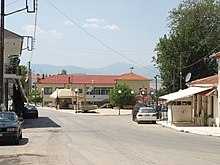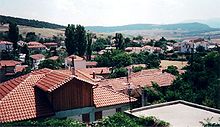Vevi
|
Local community Vevi Τοπική Κοινότητα Βεύης (Βεύη) |
||
|---|---|---|
|
|
||
| Basic data | ||
| Country |
|
|
| region | Western Macedonia | |
| Regional district | Florina | |
| local community | Florina | |
| Parish | Meliti | |
| Geographic coordinates | 40 ° 47 ' N , 21 ° 38' E | |
| Height above d. M. |
740 m Vevi center |
|
| surface | 31.696 km² | |
| Residents | 663 (2011) | |
| Population density | 20.91 inhabitants / km² | |
| LAU-1 code no. | 17010303 | |
| Local division | 1 | |
Vevi ( Greek Βεύη ( f. Sg. ); Bul. / Maz. Banitsa Баница, from it formerly Greek: Banitsa Μπάνιτσα or Panitsa Πάνιτσα) is a village in the Meliti district of the Florina municipality of the West Macedonia region in Greece and is located at the eastern end of the Florina plain. The village is built in a quarter circle on a slope. To the south rise ridges that separate Vevi from the plains of Amyndeo and Ptolemaida . To the east, ridges separate Vevi from the Macedonian plain with the towns of Edessa , Katerini and Thessaloniki in it. Road links to Thessaloniki are 160 km away and Florina is 22 km away.
history
Probably from the 15th century Vevi belonged to the Rumelia region and was part of the Ottoman Empire . The exact time of the Ottoman conquest or occupation is not known.
In 1912, the first Battle of Vevi (or Battle of Banitza ) as part of the First Balkan War took place in the Vevi area . After the Battle of Servia , which was successful for Greece at the end of October 1912, against the troops of the Ottoman Empire there, the 5th Greek Division split off from the main force striving for Thessaloniki and marched towards Florina. From November 2, 1912, Greek and Ottoman forces met at the Klidi Pass south of Vevi. The Ottoman armed forces were able to repel the Greek attack for the time being. After the fall of Thessaloniki, more Greek troops were dispatched to Bitola and Florina to the northwest from Thessaloniki. The simultaneous Serbian victory at the Battle of Bitola and the capture of the city on November 19, 1912 led to increasing military pressure and weakened the defense position east-southeast of Florina on the Klidi Pass, so that the Greek 5th Division after regrouping the Klidi Pass crossed and took the Vevi on November 19, 1912. After the liberation of Vevi by Greek troops in mid-November 1912, Vevi fell de facto to Greece, which was confirmed with the ( Treaty of Bucharest ) 1913.
During the First World War , Vevi was again the scene of fighting. On August 22, 1916, the Bulgarian troops advancing from Monastir (Bitola) and Florina conquered Vevi and one day later the ridges of the Liliakos east of the Klidi Pass. The Serbian troops fighting for the Entente in this region began a counter-offensive in September 1916: By September 2, 1916, the Bulgarian troops had to set up defensive positions against the Serbian attack in the vicinity of Vevi. On September 17, 1916, the mountain ranges of the Klidi Pass with the Mala Reka south of Vevi came under Serbian and thus Allied control.
After the Greek defeat in the Greco-Turkish War from 1919 to 1922 and the Treaty of Lausanne in 1923, which concluded this war , there was a so-called population swap between Greece and Turkey , in which the inhabitants were relocated according to ethnic and religious aspects. In 1922, a settlement was founded southwest of the original village of Vevi (since then sometimes also known as Ano Vevi) by Greek refugees from Asia Minor (Kato Vevi), who had to leave their original settlement areas in Asia Minor after the Greco-Turkish War and the Greek defeat . In 1926 the name Vevi became mandatory by decree of the Greek government (renaming).
In 1941, the second battle (or battle) of Vevi took place as part of the German Wehrmacht's Balkan campaign in World War II . As a result, Vevi came under German occupation, which ended at the end of October 1944.
From 1946, Vevi was also a scene of the Greek civil war : a not inconsiderable number of inhabitants took part in the civil war on the side of the Democratic Army of Greece (DSE - ΔΣΕ, Δημοκρατικός Στρατός Ελλάδας), which in 1949 was subject to the right-wing Greek army. As a result of the defeat, not a few participants in the civil war on the side of the communist DSE fled to Albania and especially Yugoslavia and settled there. Others found refuge in states of the former Eastern Bloc .
In the 1950s to 1970s, many residents left Vevi for economic reasons and settled in Germany , Canada and Australia , among others . Many residents and their descendants can be found in Toronto .
In addition to the economic situation, ethnic reasons were also responsible for the emigration - both after the Greek civil war and in the period from 1950 to 1980. Substantial proportions of the population of Vevi belonged to the Macedonian minority (based on Greece as a whole) (with the corresponding language ), which is not recognized as such by the Greek state at present. This minority was prevented from practicing their culture - especially during the Greek military dictatorship from 1967 to 1974. This situation has fundamentally improved after the speech democratization of Greece in 1974. Regardless of this, some residents and especially emigrants perceive Vevi as a predominantly Macedonian village. This conflict is also reflected in corresponding publications and websites from one side or the other (see web links).
The emigration has resulted in a significant population decline. According to information from villagers, between 5,000 and 10,000 people lived in Vevi from 1940–1950, although objective information on these numbers is not available. Other sources with uncertain data base determine a population of 1161 for 1913, a population of 2245 in 1940. According to the latest data surveys by the Greek Statistical Office, in 2001 only 688 inhabitants lived in Vevi. The dilapidated houses often found in the townscape are an expression of this population decline.
economy
Vevi draws its economic strength primarily from agriculture. This is carried out in family businesses. Due to the discovery of lignite , which is used as fuel in power plants in Achlada and Ptolemaida , in the area around Vevi, open-cast mines have existed since the 1980s, which made jobs for the population possible.
traffic
Vevi is located at the intersection of two main roads for the Florina prefecture and the Western Macedonia region. National Road 2 , which connects Albania with Thessaloniki and northern Greece (also European route 86 ), runs from east to west . The old national road 2 led from Vevi to the east over the Kelli pass in the north, past the lakes Petres and Vegoritida via Edessa to Thessaloniki. In winter, the route was temporarily impassable due to snowfall.
The national road 3 (also European route 65 ), which connects the Republic of Macedonia with Greece, runs from north to south . The old route to the south led over the Vevi-Amynteo pass to Amynteo and then on to Ptolemaida and Kozani. This stretch could also become impassable in winter due to snowfall.
To the west, both national road 2 and national road 3 run on a common route, which has been adapted to the increased traffic volume by a new building since 2002. To the south, national roads 2 and 3 were also combined on a new route with adaptation to the higher traffic volume.
Vevi has a train station in the Kato Vevi district, which is on the Florina-Amynteo-Edessa-Thessaloniki railway line. From 1997 to 2010, the station and the adjacent small district of Stathmos Vevis or Kato Vevi belonged to the municipality of Perasma and not like the village of Vevi to the municipality of Meliti . This curiosity was ended with the incorporation of both communities after Florina in 2011.
swell
- ↑ Information from the Greek Statistical Office according to the 2011 census ( page no longer available , search in web archives ) Info: The link was automatically marked as defective. Please check the link according to the instructions and then remove this notice.
- ↑ Results of the 2011 census at the National Statistical Service of Greece (ΕΛ.ΣΤΑΤ) ( Memento from June 27, 2015 in the Internet Archive ) (Excel document, 2.6 MB)
- ↑ Πανδέκτης: Μπάνιτσα - Βεύη . Retrieved on May 2, 2009. ( Page no longer available , search in web archives ) Info: The link was automatically marked as defective. Please check the link according to the instructions and then remove this notice. National Hellenic Research Foundation / Greek National Documentation Center
- ↑ Newspaper article in the Greek newspaper Embros from November 9, 1912, page 4, right column.
- ↑ Newspaper article in the British newspaper The Times, November 5, 1912, p. 8.
- ↑ a b c Friedrich Immanuel. The Balkan War 1912/13. Second and third booklet. The war up to the beginning of the armistice in December 1912. Verlag Ernst Siegfried Mittler and Son, 1913. p. 94.
- ^ Newspaper article in the US newspaper New York Times of November 5, 1912.
- ↑ New York Times newspaper article from August 23, 1916 (in English, PDF file)
- ↑ New York Times newspaper article from August 24, 1916 (in English, PDF file)
- ↑ New York Times newspaper article from September 2, 1916
- ↑ New York Times newspaper article from September 17, 1916 (in English)
- ↑ Decree of the President of February 9, 1926. Published in the government newspaper (Efimeris tis Kyvernisis) FEK 55, Volume A, p. 405, left column, points 16, of February 15, 1926. Available from the National Printing Office of Greece (Ethniko Typografio) ( in Greek). Last accessed: August 14, 2010.
- ↑ Population figures of the Hellenic Statistical Office 2001, broken down into localities, municipal areas and municipalities ( Memento of April 18, 2009 in the Internet Archive ) (PDF; 895 kB)
Web links
- Site of the municipality of Florina (Greek)
- Florina Regional Unit site (Greek)
- Website with archaeological finds from Vevi (English)
- Data from the Greek Statistical Office for 2001; other provider ( Memento from September 28, 2011 in the Internet Archive ) (Greek)
- Website of former residents of Vevi who belong to the Bulgarian population group





